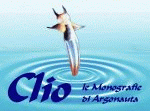
Clio Supplemento a Argonauta 7-12 2012
 |  |
Murella sicana (Férussac, 1822)
E’ stato pubblicato, abbastanza di recente un lavoro : Liberto F., Giglio S., Reitano A., Colomba M.S. & Sparacio I., 2010 Molluschi terrestri e dulciacquicoli di Sicilia della collezione F. Minà Palumbo di Castelbuono. Monografie Naturalistiche, 2. Edizioni Danaus, Palermo, 136 pp. Fra le numerose considerazioni ce n’è una che personalmente non solo condivido, ma che mi fa piacere in quanto avevo la sensazione che si trattasse di due specie assolutamente distinte (almeno morfologicamente). Mi sto riferendo alla Murella platychela alla quale erano finora ascritti tutti i ritrovamenti del Monte Pellegrino oltre a quelli del palermitano e della Sicilia nord occidentale, dalla quale vengono distinti adesso , sotto la specie Murella sicana, gli esemplari che si rinvengono sul Monte Pellegrino e che sono particolarmente caratteristici per la forma conchiliare a "pallina" con la bocca piccola non prominente come nelle M. platychela di altre località. Ovviamente valgono tutte le considerazioni, espresse nel volume, relative agli studi effettuati da Fiorentino et. al. nel 2007, 2008 e 2010, basati su analisi di genetica molecolare e che hanno, per certi versi , rivoluzionato le conoscenze precedenti, senza però, per ora, effettuare nessuna reinterpretazione sistematica. Oltre alla morfologia della conchiglia c'è da dire che Fiorentino et al. 2010 scrivono al proposito di questa specie : "The second (MP) occurs in an isolated area, maintains a certain genetic distance from the other Sicilian populations and is morphologically distinct on the basis of shell and genital characters" (Figs. 4 and 6; Fiorentino et al., 2008b). Mantenendo pertanto validi, in attesa, i raggruppamenti classici, io sono assolutamente convinto che la decisione, da parte degli Autori di considerare M. sicana specie distinta oltre alle classiche specie siciliane, sia quanto mai opportuna e mi chiedo come sia possibile che, finora, la stessa fosse ritenuta conspecifica di M. platychela. Sul monte Pellegrino la specie è presente nella sua colorazione completamente bianca con rare eccezioni di esemplari con bande bruno rossastre. La specie è esclusiva del Monte Pellegrino, sopra a Palermo, dove si rinviene piuttosto frequentemente almeno nella livrea bianca, molto rara invece, per la mia esperienza, gli esemplari con le bande scure. Si rinvengono esemplari sia di dimensioni classiche che altri, meno frequenti, di dimensioni piccole. La specie trova, specialmente nella parte alta del monte, un ambiente favorevole per il riparo, nelle cavità prodotte da Cornu (Erctella) mazzullii (De Cristofori & Jan, 1832) . | It is was published quite recently a publication: Liberto F., Giglio S., Reitano A., Colomba M.S. & Sparacio I., 2010 Molluschi terrestri e dulciacquicoli di Sicilia della collezione F. Minà Palumbo di Castelbuono. Monografie Naturalistiche, 2. Editions Danaus, Palermo, 136 pp. Among the many considerations, there is one who not only personally share, but I am glad because I had the feeling that they were two completely separate species (at least morphologically). I am referring to Murella platychela which were previously ascribed all the findings of Monte Pellegrino in addition to those of Palermo and Northwest of Sicily, from which they are separated now, under the species Murella sicana, specimens that are found on Monte Pellegrino and that are particularly characteristic for the shell shape like a "little round spot" with a small mouth not prominent as in M. platychela from other places. Obviously all the considerations, expressed in volume, relating to studies carried out by Fiorentino et. al. in 2007, 2008 and 2010, based on analysis of molecular genetics and who, in some ways, revolutionized prior knowledge, without, for now, to make any systematic reinterpretation. In addition to the morphology of the shell there is to say that Fiorentino et al. 2010 to write about this species: "The second (MP) Occurs in an isolated area, maintains a certain genetic distance from the other Sicilian populations and is morphologically distinct on the basis of shell and genital characters" (Figs. 4 and 6; Fiorentino et al., 2008b). Retaining therefore valid, waiting, classic clusters, I am absolutely convinced that the decision by the Authors to consider M. sicana distinct species as well as traditional Sicilian species, is very timely and I wonder how it is that, so far, the same was considered conspecific with M. platychela. On Mount Pellegrino, the species is present in his all-white color, with rare exceptions of specimens with reddish brown bands. The species is unique to the Monte Pellegrino, Palermo above, where it is found quite frequently at least in white livery, very rare however, in my experience, the specimens with dark bands. There are found specimens of both classic dimensions that other, less frequent, of small dimensions. The species is, especially in the upper part of the mountain, a favorable environment for the shelter in the cavities produced by Cornu (Erctella) mazzullii (De Cristofori & Jan, 1832). |
